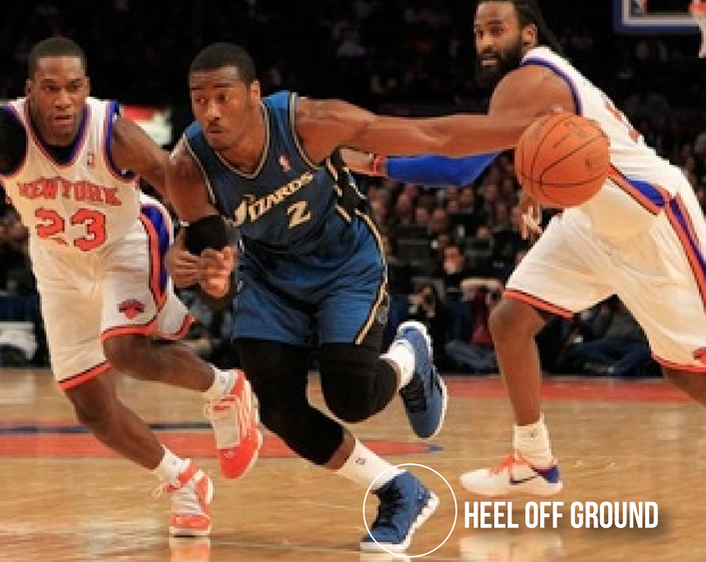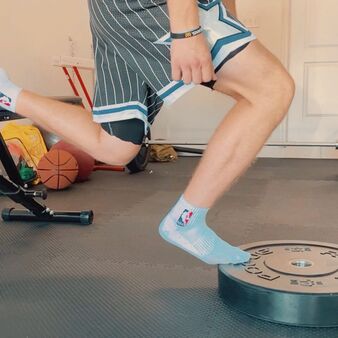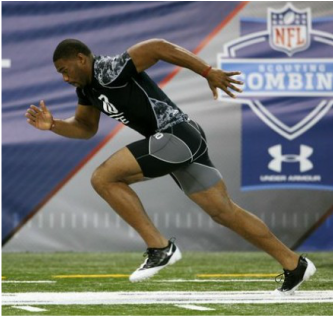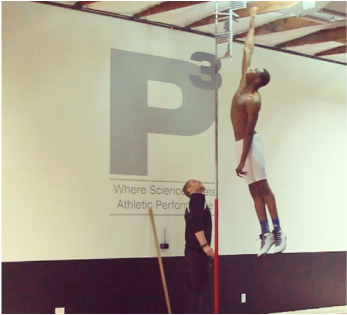|
With foot and ankle complex training becoming more and more popularized each year, you've heard it before: the foot is instrumental to athletic performance because it is literally the first interaction with the ground on most sporting movements. And as you well know, shoes can and will not only kill our chances of developing a properly-functioning foot, but make it difficult to mitigate this issue with training. So we need very targeted methods in our training arsenal. There are seemingly endless ways to train this foot-ankle machinery as simple as warming up and/or training barefoot, to barefoot proprioception, to towel foot curls, and none of them are wrong, but one way that's been gaining some traction in the performance world is the "floating heel." How does the ankle/foot complex interact with the ground? Take a look at essentially any explosive movement in basketball. Do you see the heel interacting with the ground? Deceleration, yes. Of course.. But acceleration? More slight changes of direction? The block foot in a bilateral jump? Max speed sprints? That heel, hopefully, won't touch the ground. If it were to touch the ground, the stored energy in the achilles tendon and connective tissue will be immediately lost, and that movement is going to become quite less explosive and much more taxing.
What is a "floating heel?"
Benefits of floating heel exercises: I find the benefits of floating heel exercises to be three-fold. I'll keep them pretty brief!
Conclusion The floating heel, like every other concept employed by S&C professionals, isn't the magic wand on an athlete. It's a tool. If you use it, you'll probably get some benefits. If you don't, there are other ways to get these same benefits too! In terms of how to use them, I don't have much experience using them with athletes because they have somewhat recently come to the forefront and I am experimenting on myself first, but I'd begin with the isometrics, include them here and there with your accessory hypertrophy work, and eventually progress to loading them or using the drop catch option. Just my thoughts. Feel free to let me know in the comments where else you see opportunities for this concept to be used, if you've ever used them, or even call me out on bullshit! Any conversation is welcome. Stay safe everyone.
5 Comments
I'll say it over and over... speed in basketball is overrated. Will there be times that you'll be going at 90-100% of your top-end speed? Yes. But compared to the times that you'll be accelerating to a 70-90% of your speed? It's almost nothing. So we focus primarily on that in our training--those quick bursts that will give you your real advantages. Check out a great workout for those quick bursts below:
Y'all asked for it on IG, so here it is! Sand workouts are one of the best workouts you can do for basketball. They're not always available because of weather and sand accessibility, but if you got the resources, you're crazy to not be doing them at least once a month. They're easy on your joints, meaning less knee pain and overall less impact up the kinetic chain, but at the same time very effective in how much they resist and challenge your body. They require ankle mobility and calf/achilles strength, robust lower body muscles, and obviously a strong mindset providing that you go hard! So, below is the downloadable version of the workout you can see us doing on Instagram, with demonstrations in the videos below. Enjoy it, and go challenge yourself! 💪
What does every athletic movement have in common? What do sprinting, grabbing a rebound, shooting a jumper, and blowing by a defender have in common? Triple extension. Quite simply, triple extension is the simultaneous (well, actually sequential, separated by milliseconds) extension or, potentially, locking, of the ankle, knee, and hip joint. If every athlete can maximize each of these extensions, the chain will move much more explosively as a whole, thus placing more force into the ground and propelling the athlete forward or vertically at a higher rate. How Does This Work? When you truly think about it, triple extension is not very complicated biomechanically. If you lock out your joints, your posterior muscles (gluteus, hamstrings, and soleus, particularly) transfer energy more efficiently and powerfully, which makes sense because you are fully contracting your muscles concentrically. Because of the sequential contractions, the distal joints (knee and ankle) can produce more force than if they were isolated. In other words, the joint(s)/muscles above the knee and ankle provide an additional power source, which for example allows the ankle to produce 6 times as much force than in isolation (UMass). Additionally, because your lower-body posterior muscles are some of the most powerful in the body (particularly the gluteus maximus and soleus), it is important to expend as much force from these muscles as possible. Let's take a closer look at how this works in various movements. In sprinting, your hip extends first, providing not only power from the gluteus but balance to take the simultaneous step. Then, the knee locks to expend power from the quadriceps, and finally the ankle plantarflexes to help propel off of the ground with the soleus. Check out the clip below for a graphic. In a vertical jump, triple extension acts in a very similar method, but in the vertical plane. Check out the video below for a graphic. Injury Prevention
In addition to improving performance, the concept of triple extension is very important to the prevention of ankle, knee, and hip injuries in explosive sports, particularly basketball. Primarily, one must ensure that these joints can move efficiently throughout the entire range of motion, or else one cannot fully extend, and if they do, injuries are bound to occur. Thus, ankle and hip mobility exercises are vital (as they are free-moving ball and socket joints), as well as making sure that the surrounding muscles (gastrocnemius, soleus, gluteus, quadriceps, and even hamstrings, hip flexors, and abductors/adductors) are not dangerously tight. Also, when you understand that the hip, knee, and ankle joints work sequentially to perform explosive movements, you can understand why ensuring that each is effective in its movement. Otherwise, the other two joints take a beating, especially the closest proximal joint (above). For example, when the ankles cannot plantarflex effectively, the knees must make up for it, spiking the injury risk for tears and overuse injuries such as tendinitis. How To Train Triple Extension In maximizing one's ability to extend at all three joints, you simply want to focus on movements that are biomechanically similar and mimic the sequential extension. There are two ways to do this (both of which must be implemented into a training program): (1) isolating and strengthening the extension of each joint, and (2) performing exercises that include all three. For example, deadlifts (particularly hex/trap bar deadlifts) primarily strengthen the hips' ability to extend--these are especially important due to the huge amount of strength in the gluteus. However, this is still a compound exercise, meaning that it includes more than one joint. This is something to make sure that most of your exercises involve (squats are another great one) The second part, exercises that extend at the hip, knee, and ankle simultaneously, can be accomplished through strength/explosiveness exercises (explosive step ups with ankle extension, explosive squats to presses, tire flips, kettle bell swings and variations, etc), plyometrics (box jumps, non-countermovement jumps, etc), and olympic lifts (cleans, snatches)--which are more advanced. On all of these, though, focus on extending all three joints powerfully, and it will bring you to your maximum potential. Sources: http://www.umass.edu/locomotion/pdfs/scj-1998.pdf |
Coleman AyersFounder/Owner of By Any Means Basketball Categories
All
Archives
September 2020
|
||||||||||||||||||||||||||
|
By Any Means Basketball is a Miami, Florida-based basketball and athletic performance training organization, centered around using science-based training methods to optimize performance and shift the global basketball culture.
Email: [email protected] Twitter: @byanymeansbball Instagram: @byanymeansbasketball YouTube: By Any Means Basketball Privacy Policy |





 RSS Feed
RSS Feed
